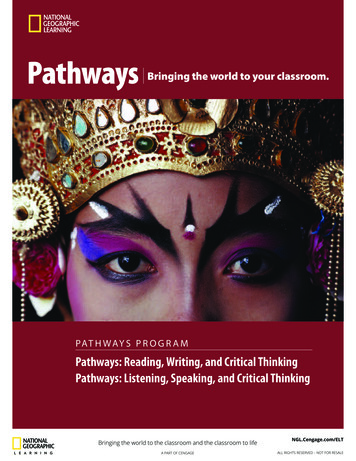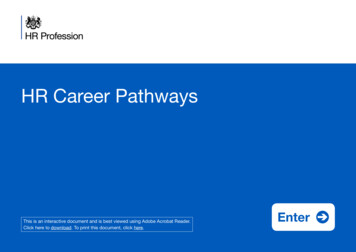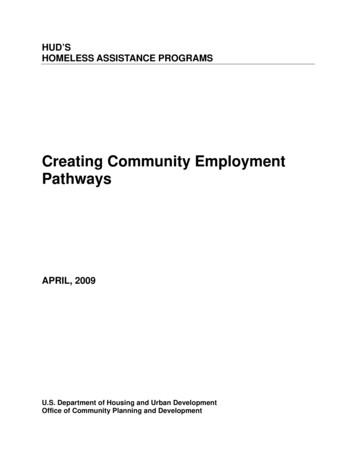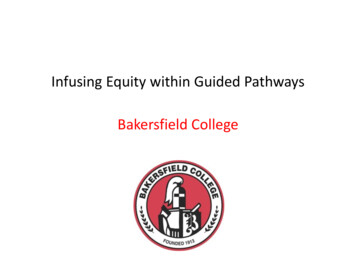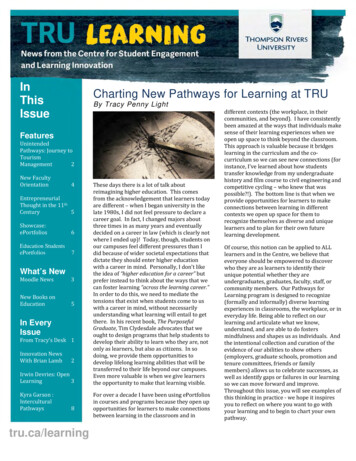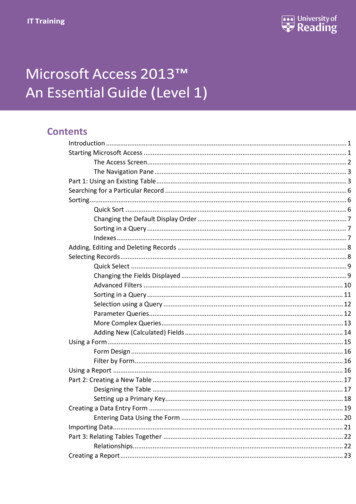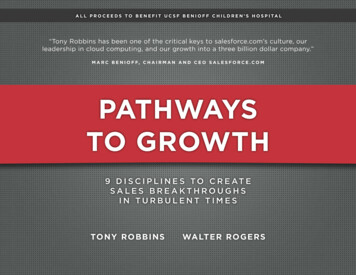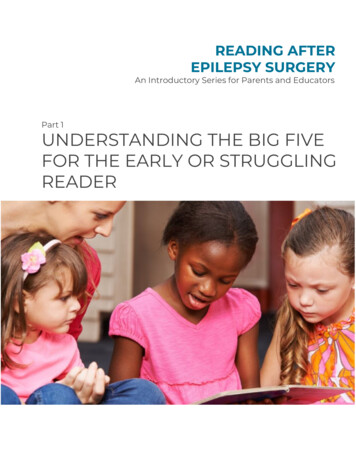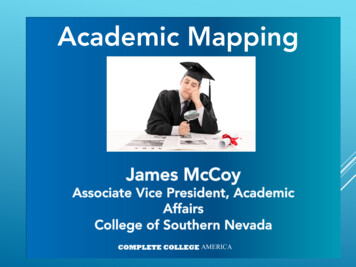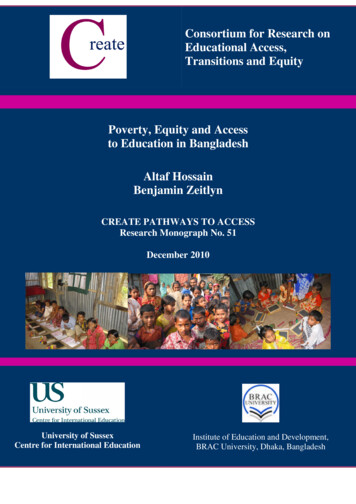
Transcription
Consortium for Research onEducational Access,Transitions and EquityPoverty, Equity and Accessto Education in BangladeshAltaf HossainBenjamin ZeitlynCREATE PATHWAYS TO ACCESSResearch Monograph No. 51December 2010University of SussexCentre for International EducationInstitute of Education and Development,BRAC University, Dhaka, Bangladesh
The Consortium for Educational Access, Transitions and Equity (CREATE) is a Research ProgrammeConsortium supported by the UK Department for International Development (DFID). Its purpose is to undertakeresearch designed to improve access to basic education in developing countries. It seeks to achieve this throughgenerating new knowledge and encouraging its application through effective communication and disseminationto national and international development agencies, national governments, education and developmentprofessionals, non-government organisations and other interested stakeholders.Access to basic education lies at the heart of development. Lack of educational access, and securely acquiredknowledge and skill, is both a part of the definition of poverty, and a means for its diminution. Sustained accessto meaningful learning that has value is critical to long term improvements in productivity, the reduction ofinter-generational cycles of poverty, demographic transition, preventive health care, the empowerment ofwomen, and reductions in inequality.The CREATE partnersCREATE is developing its research collaboratively with partners in Sub-Saharan Africa and South Asia. Thelead partner of CREATE is the Centre for International Education at the University of Sussex. The partners are:The Centre for International Education, University of Sussex: Professor Keith M Lewin (Director)The Institute of Education and Development, BRAC University, Dhaka, Bangladesh: Dr Manzoor AhmedThe National University of Educational Planning and Administration, Delhi, India: Professor R GovindaThe Education Policy Unit, University of the Witwatersrand, South Africa: Dr Shireen MotalaThe Universities of Education at Winneba and Cape Coast, Ghana: Professor Jerome Djangmah,Professor Joseph Ghartey AmpiahThe Institute of Education, University of London: Professor Angela W LittleDisclaimerThe research on which this paper is based was commissioned by the Consortium for Research on EducationalAccess, Transitions and Equity (CREATE http://www.create-rpc.org). CREATE is funded by the UKDepartment for International Development (DFID) for the benefit of developing countries and is coordinatedfrom the Centre for International Education, University of Sussex. The views expressed are those of theauthor(s) and not necessarily those of DFID, the University of Sussex, or the CREATE Team. Authors areresponsible for ensuring that any content cited is appropriately referenced and acknowledged, and that copyrightlaws are respected. CREATE papers are peer reviewed and approved according to academic conventions.Permission will be granted to reproduce research monographs on request to the Director of CREATE providingthere is no commercial benefit. Responsibility for the content of the final publication remains with authors andthe relevant Partner Institutions.Copyright CREATE 2010ISBN: 0-901881-58-9Address for correspondence:CREATE,Centre for International Education, Department of EducationSchool of Education & Social WorkEssex House, University of Sussex, Falmer BN1 9QQUnited KingdomTel: 44 (0) 1273 877984Fax: 44 (0) 1273 877534Author email:altafh28@gmail.comb.o.zeitlyn@sussex.ac.uk / orgEmailcreate@sussex.ac.ukPlease contact CREATE using the details above if you require a hard copy of this publication.
Poverty, Equity and Accessto Education in BangladeshAltaf HossainBenjamin ZeitlynCREATE PATHWAYS TO ACCESSResearch Monograph No. 51December 2010
ii
ContentsPreface.viSummary .vii1. Introduction.12. The effects of poverty on educational access in Bangladesh.32.1 Access to education and income .42.2 Private tuition.52.3 Silent exclusion and income .63. Manifestations of poverty and silent exclusion .93.1 Health and access to education .93.2 School equipment and access to education .113.3 School type and access to education.144. Current policies to tackle poverty and unequal access to education.164.1 Pre-primary schooling in Bangladesh .164.2 The Primary Education Stipend Project.174.3 The Secondary Female Stipend Programme.195. Conclusions.215.1 Policy recommendations.22References.24List of TablesTable 1: Proportions of households by food security status – ComSS 2009 and EducationWatch 2004 .3Table 2: Monthly income of households from the ComSS by food security status .4Table 3: Percentage of students receiving private tutoring, 2005.6Table 4: Percentages of children at primary and secondary level by components of silentexclusion and gender.7Table 5: Mean monthly income of the households of the silently excluded children at primaryand secondary level.7Table 6: Proportion of children with inadequate learning materials by school type .15List of FiguresFigure 1: Proportion of children in school, dropped out and never enrolled by income group.5Figure 2: Percentages of children by different health status who are silently excluded.11Figure 3: Percentages of children with and without bags who are silently excluded .12Figure 4: Percentages of children with and without geometry boxes who are silently excluded.13Figure 5: Percentages of children who had all their schoolbooks and those that did not whoare silently excluded .14Figure 6: Percentages of 6-15 year-old children who are enrolled in pre-primary school byfood security status and gender.17Figure 7: Number and proportion of primary school children who receive the primaryeducation stipend by food security status of their household .19Figure 8: Number and proportion of girls receiving and not receiving the secondary femalestipend .20iii
List of SFSPTk.Building Resources Across CommunitiesCommunity and School StudyConsortium for Research on Educational Access, Transitions and EquityFood for EducationFemale Stipend ProgrammeGovernment of BangladeshGross National IncomeGovernment Primary SchoolNon-government OrganisationPrimary Education Stipend ProjectRegistered Non-government Primary SchoolSecondary Female Stipend ProgrammeTaka (currency of Bangladesh)iv
AcknowledgementsWe would like to acknowledge the help of the research assistants who collected all the datafrom six areas in two rounds. We would also like to thank Professor Keith Lewin for hiscomments and suggestions throughout the process of writing this monograph, Dr. RicardoSabates for his help with statistical analysis and Stuart Cameron for his suggestions andinsights into the prevalence and effects of private tuition. We are grateful to CREATE and theInstitute of Educational Development-BRAC University for giving us chance to worktogether and write this monograph. We would also like to acknowledge the work of JustineCharles in preparing this monograph for publication.v
PrefaceThis paper explores aspects of equitable access in Bangladesh using a large data set from sixdistricts across the country. This shows how strongly poverty affects access to primary andsecondary schools. It also influences the extent of silent exclusion – children who are overage, irregularly attending, and under achieving. Though considerable gains have been madein improving overall levels of access it is clear that inequalities remain large and may even begrowing. Schemes designed to reduce inequality have suffered from poor targeting andinefficient implementation.The paper argues that new approaches are needed that disaggregate different types of inequitythat may have different causes. Health interventions are likely to be needed coupled withmore effective channelling of resources towards meeting the needs of the poorest groups. Thedirect and indirect costs to poor households need to be minimised. Indicators of equity shouldbe included in monitoring progress on Education for All to call government to account inmaking a reality of its promises to universalise access to education. This monograph, alongwith other CREATE research on Bangladesh, paint a picture both of progress and of need.Collectively they form the basis for new policy dialogues designed to learn from theexperience of the recent past and the evidence generated from the CREATE studies.Keith LewinDirector of CREATECentre for International EducationUniversity of Sussexvi
SummaryBangladesh has made great improvements in the scale and quality of access to education inrecent years and gender equality has almost been achieved in primary education (WorldBank, 2008). Evidence from CREATE’s nationwide community and school survey (ComSS)confirms results from other research (such as Al-Samarrai, 2009) which suggests that povertyremains a barrier to education for many in Bangladesh, where 40% of the population remainbelow the poverty line (World Bank, 2009). The ComSS data suggest that policies that havebeen introduced to enable the poor to attend school such as free schooling; subsidisedschoolbooks and stipends are not accurately targeted or having the desired effects. Targetedassistance for sections of society who are denied access to education in what is meant byequity in this paper. This goes beyond equal opportunity and seeks justice for those who havebeen left out.In this monograph we describe the influence of poverty (measured by income and foodsecurity) on indicators of access to education covered by CREATE’s conceptual model, suchas children who drop out of school, children who have never enrolled and silent exclusion(measured through poor attendance, poor attainment and repetition). These relationshipsshow a pattern of a series of interrelated links between poverty and exclusion from education.While the links between physical exclusion from education (never having been to school ordropping out of school) and poverty are relatively easy to understand, it is harder tounderstand why poor children who are in school do worse and repeat more than their peersfrom wealthier households. We explore correlations between indicators of silent exclusionfrom education and health, access to adequate school materials and the type of schoolattended. What we find is that those who have poor health, lack basic school equipment andlive in the catchment areas of non-government schools (who are also often the poor) are morelikely to be silently excluded – that is enrolled and overage, attending irregularly or poorlyachieving. Using this detailed data we identify policies that will have the greatest effect onimproving access to education for those currently out of school and those in school but notlearning.vii
viii
Poverty, Equity and Access to Education in Bangladesh1. IntroductionEquitable access to education implies more than equal opportunities in that it means ensuringadditional and particular support for the poorest and most marginalised. Equity in educationrequires interventions to ensure that the barriers to access to education faced by certainsections of the population are overcome through well-targeted policies. In this paper weexplore the strong relationships between poverty and some related indicators and access toeducation. The Consortium for Research on educational (CREATE) conceptual modelexpands the idea of access, revealing that it does not simply mean that children must be inschool – what happens in the school is important too (Lewin, 2007).While equitable access to education is much discussed, the discourse on equitable access toeducation in Bangladesh usually focuses on poor children’s physical access to school andonly rarely touches on access to education that results in meaningful learning. For this reason,most policy interventions are targeted at meeting the needs of the family in terms of food orcash rather than children’s actual learning. The precise types of support needed for poorchildren at school are neither identified nor provided.According to Lewin (2007) access to education is not meaningful unless it results in:1. Secure enrolment and regular attendance;2. Progression through grades at appropriate ages;3. Meaningful learning which has utility;4. Reasonable chances of transition to lower secondary grades, especially where these arewithin the basic education cycle.5. More rather than less equitable opportunities to learn for children from poorer households,especially girls, with less variation in quality between schools (Lewin, 2007:21)This definition of meaningful access is the basis of CREATE’s broad view of access andconceptual model. To measure equitable access to education, this monograph uses indicatorsof access to education that relate to CREATE’s conceptual model of ‘zones of exclusion’.Access to pre-school (zone 0), levels of children never enrolled (zone 1), children who dropout of school (zones 2 and 5) and children who are at risk of exclusion or ‘silently excluded’(zones 3 and 6). Children at risk of exclusion are measured through their levels of attendance,attainment and the extent to which they are the correct age for their grade (Lewin, 2007). Insection three we focus specifically on silent exclusion in order to examine some of thecorrelations between important manifestations of poverty and silent exclusion fromeducation, which is difficult to measure and observe.This paper uses these indicators, and data from the 2007 and 2009 rounds of the CREATEcommunity and school survey (ComSS). The ComSS was based in six locations, one in eachadministrative division of Bangladesh. The survey included 6,696 households and 36 schools,and a total of 9,045 children aged between 4 and 15. This data was disaggregated by gender,disability, income, food security and type of school. While for all these indicators, significantrelationships can be established, the indicators relating to poverty: income and food securityhad the biggest, most cross cutting and significant effects. For this reason we focus here uponpoverty related indictors of inequality and their relationship with access to education in order1
Poverty, Equity and Access to Education in Bangladeshto propose the most effective policy interventions for equitable access to education for all inBangladesh.This is not to say that other forms of inequality such as gender inequality in education are notimportant. Bangladesh has achieved gender parity in enrolment at both primary andsecondary education levels and has made progress towards increasing enrolment (WorldBank, 2008; Raynor and Wesson, 2006:3). This is a great achievement for Bangladesh, butmust not lead to complacency. As we discussed above, enrolment is only part of the story anddoes not guarantee access. Despite increases in enrolment, girls in Bangladesh are still lesslikely to complete secondary school, gain an academic qualification, study subjects that havea good marketable value, or to move on to paid employment. Girls are still significantly lesslikely to be entered for secondary school exams or to pass them – so despite equal enrolmentwhat happens in school is not equal (Raynor and Wesson, 2006:7). In this way genderequality in education in Bangladesh highlights CREATE’s concept of meaningful access. Inthis paper we show similar effects and relationships regarding indicators of poverty.Almost all education research done in Bangladesh has identified a strong correlation betweenpoverty and exclusion from education. Al-Samarrai (2009) has shown in a recent study thatthe:Inequality in enrolment widens as children move up the education system with childrenin non-poor households twice as likely to be enrolled in secondary school as their poorcounterparts. This is partly due to higher primary school completion rates among nonpoor children. Access to tertiary education is heavily restricted but inequalitiescontinues to widen; non-poor households are six times more likely to be enrolled inpost-secondary than children from poor households. (Al-Samarrai, 2009:168)Primary education is free and compulsory in Bangladesh, textbooks are also provided free.However there remain other direct and opportunity costs of education. The government hasset up stipend schemes to pay for some of these costs for the poor and for girls. Evidencefrom the ComSS suggests, however, that the poor are still significantly excluded from basiceducation, in terms of non enrolment, drop out and silent exclusion. Therefore we willexamine: What is the relationship between household income and access to education? Insection 2.Manifestations of poverty that are associated with silent exclusion from education, insection 3.What current policies on equity in education are being pursued in Bangladesh andwhy they have not been effective? In section 4.In the light of the evidence, which policy interventions will have the largest effect onimproving access to education for the poor? In section 5.2
Poverty, Equity and Access to Education in Bangladesh2. The effects of poverty on educational access in BangladeshPoverty is complex and multidimensional, and can be measured in different ways. In thisstudy we use two relatively simple measures of poverty, one is monthly household incomeand the other is food security. Food security status can be used as an indication of overalleconomic status. Respondents in the ComSS were asked to recall and make an assessment ofincome and expenditure of all the members of the household during the previous year, withhelp from the interviewer. They were then asked to place themselves in one of the fourcategories in regard to perceived food security in the household - always in deficit,sometimes in deficit, sufficient to meet the needs, and surplus.ComSS data showed that 12% of the total households suffered from constant food insecurity,while around one third of the households suffered from intermittent food insecurity. A littleover a third were found to have enough to meet their food security needs, whereas only18.8% were in the surplus food security category. Ahmed et al. (2005) used a similarcategorisation of food security in their household survey of 8,212 households at 10 locationsin the six administrative divisions of Bangladesh. They found that 3.2% of respondents werefrom households always in food deficit, 19.9% were sometimes in deficit, 45% had enough tomeet their needs and 31.9% had a surplus (Ahmed et al. 2005:64) (see Table 1).Table 1: Proportions of households by food security status – ComSS 2009 andEducation Watch 2004Always in deficit Sometimes in deficit Have enough / Break even11.6%31.4%37.5%ComSS 20093.2%19.9%45%Education Watch2004Sources, ComSS (2009) and Education Watch 2004 - Ahmed et al., (2005:64)Surplus19.5%31.9%The locations selected for Ahmed et al (2005) were selected in order to represent a range ofsocio economic conditions, based on World Food Programme classifications and were basedin urban and rural areas (Ahmed et al. 2005:xxvii). Locations selected for the CREATEComSS (2009) were only rural and selected to represent a geographical spread and thepresence of local NGOs. Other CREATE research (Cameron, 2010) focuses on access toeducation for the urban poor in Bangladesh. These factors explain why the levels of foodinsecurity are different, and the ComSS respondents are poorer than other large nationalsurveys.3
Poverty, Equity and Access to Education in BangladeshTable 2: Monthly income of households from the ComSS by food security statusMean monthly householdMean monthly household1Number ofincome in Takaincome in DollarsAlways in deficit3,074.2244.55772Sometimes in 10,809.55156.661,204Average / Total5,964.6686.446,450Have enough / breakevenhouseholdsSource: ComSS, 2009Clearly this is a sample of the poor, so when we are examining the relationships betweenpoverty and indicators of access to education using this data, we are examining the very poorrelative to the poor (Table 2). 90% of individuals in this sample lived below the US 1 perday poverty line (Sabates and Hossain, 2010:21) compared to 40% nationally (World Bank,2009). In the next section we discuss the strong correlations between access to education andincome. The fact that the correlations between access and income are so strong, even betweenthe poor and the very poor indicates that interventions targeted at the severely marginalisedcan make a difference to access to education.2.1 Access to education and incomeEvidence from many studies shows that educational access is strongly determined byhousehold income (Lewin, 2007; Filmer and Pritchett, 2001). Although primary education isfree and compulsory in Bangladesh, research indicates that there are substantial additionalprivate costs and opportunity costs of education that parents must meet for their children’sschooling (Ahmad, et al., 2007, Ahmed et al, 2005). These costs include examination fees,private tuition (which we discuss below) and paying for notebooks in the upper grades ofprimary school.ComSS data also shows the high private costs of education per child per year. The averagecost per child per year of attending primary school was Tk. 3,812, (about 55) slightly morefor boys (Tk. 3,935) and slightly less for girls (Tk. 3,692). The average yearly income perperson is Tk. 14,315.18 or around US 207 in this sample. World Bank figures forBangladesh in 2008 put gross national income (GNI) per capita at US 520 (World Bank,2009). Bearing in mind that these are averages, and that within this poor sample there isconsiderable variation, it is not hard to see why the poor struggle to pay the costs of educatingtheir children.Figure 1 shows the starkly unequal participation of children in education from differentincome groups. Households which have less than Tk. 2,000 income per month ( 29) aresending almost 25% fewer of their children to school than those who are in the Tk. 8,000( 115) and above income group. Average family size is five – so households with incomes ofTk. 8000 per month, with five people have under a dollar per day per person.1In 2009 US 1 was equivalent to about 69 Taka, the average household size in the sample was five members.4
Poverty, Equity and Access to Education in BangladeshFigure 1: Proportion of children in school, dropped out and never enrolled by 98000 6220%0%100-1999Monthly Average income of household (Taka)In schoolDropoutNever enrolledRates of dropout and proportions of children who have never been enrolled are inverselycorrelated to the increase of family income (Figure 1). 12% of children from householdsliving on incomes below Tk. 2,000 per month had never been enrolled in school at all, whilea quarter had started school but dropped out. In families earning more than Tk. 8,000 permonth meanwhile, 2.6% of children had never been enrolled and 10.6% had dropped out ofschool. The fact that income is such a strong determinant of access to education indicates thatpolicies making education free and compulsory, free school books, along with other policyinterventions which we will discuss in section four are not enough to bring about universalaccess to primary education. Even with these interventions, going to school has costs, whichare high as a proportion of income for the poor.2.2 Private tuitionOne of the major costs of education in Bangladesh is private tutoring which is additional tocosts directly associated with schools. This has implications for the pedagogy in schools, lowattainment and particularly for the silent exclusion of the poor. The scale and importance ofprivate tutoring is a phenomenon that is perpetuating inequality in education in Bangladesh.Tutors help prepare children for school exams, and children without private tutors performpoorly in exams. This is partly because of the expectation that children will learn outside theclassroom. Many teachers’ perception of teaching is that it should involve giving homeworkand checking it in school. They expect that children will do most of their learning at homeand that teachers must just guide pupils and correct homework (Ahmed et al., 2005:72). Thisalso has implications for the opportunity costs of education. Children who, by necessity, haveresponsibilities to contribute to the family income and cannot spend adequate time to study athome are at risk of poor attainment and dropout.5
Poverty, Equity and Access to Education in BangladeshAccording to Ahmed et al. (2005), in the Education Watch sample discussed earlier, 43% ofchildren had private tutors, paying an average of Tk. 152 per month for their services(Ahmed, et al., 2005:xxxii). First generation learners, the group likely to benefit most fromprivate tuition, were least able to afford it. Children from wealthier families and those whoseparents were better educated were more likely to have tutors.Table 3 shows the incidence of private tuition in different types of school. The likelihood ofreceiving private tutoring appears to correspond to the socioeconomic status of the familiessending children to each type of school. This suggests that private tuition depends on thefamily’s ability to afford it more than on the characteristics of each type of school. Forinstance, registered non-government primary schools (RNGPS) are perceived to be of lowquality, but parents do not seem to be investing in private tuition to compensate for theschools’ shortfalls – presumably because they cannot afford to.Table 3: Percentage of students receiving private tutoring, 2005School type GPSRNGPS Non-formal Madrasa32.128.512.320.2%Source: Nath, 2008, using data from Education Watch 2005.Kindergarten69.3Secondary attached63.2According to Tietjen (2003): private tuition compensates for poor quality education inschools and augments teachers’ salaries. She reports findings from a World Bank survey, inwhich a quarter of households “indicated that teachers would inflict some sort of retribution(not teach in school, give poor grades) if not engaged for private tutoring” (Tietjen, 2003:19).Nath (2008) concludes that private tutors for primary school students have become a “wellaccepted norm”. In discussions, parents expressed the view that “If a school functions well,private tutoring is unnecessary, but the schools do not function well” and that students werenot able to ask teachers questions in school, but were able to do this in private tuition (Nath,2008:19).Teachers therefore have incentives to teach poorly and to make extra money through tutoring.This is one of many subtle mechanisms within schools that contribute to silent exclusion ofthe poor from education.2.3 Silent exclusion and incomeAlong with the never enrolled (zone 1) and those who have dropped out from primary school(zone 2), the CREATE model of zones of exclusion includes those who are in school but atrisk of dropping out (zone 3). These children are low-attenders, repeaters and low-achievers,and are referred to by Lewin as ‘silently excluded’ (Lewin, 2007:23).The identification of silently excluded children is by its very nature, difficult. To identifychildren who are silently excluded, the ComSS in 2007 and 2009 exa
Poverty, Equity and Access to Education in Bangladesh 1. Introduction Equitable access to education implies more than equal opportunities in that it means ensuring additional and particular support for the poorest and most marginalised. Equity in education requires interventions to ensure that the barriers to access to education faced by certain
